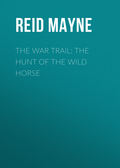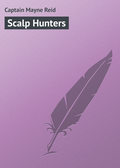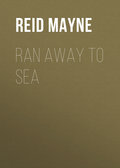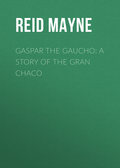
Майн Рид
Popular Adventure Tales
CHAPTER X.
THREE CURIOUS TREES
Next morning they were awake at an early hour. There was still enough of the tongues and grouse left, along with some ribs of the antelope, to breakfast the party; and then all four set out to bring the flesh of Basil's buffaloes into camp. This they accomplished, after making several journeys. It was their intention to dry the meat over the fire, so that it might keep for future use. For this purpose the flesh was removed from the bones, and after being cut into thin slices and strips, was hung up on poles at some distance from the blaze. Nothing more could be done, but wait until it became sufficiently parched by the heat.
While this process was going on our voyageurs collected around the fire, and entered into a consultation about what was best to be done. At first they thought of going back to the Red River settlement, and obtaining another canoe, as well as a fresh stock of provisions and implements. But they all believed that getting back would be a toilsome and difficult matter. There was a large lake and several extensive marshes on the route, and these would have to be got round, making the journey a very long one indeed. It would take them days to perform it on foot, and nothing is more discouraging on a journey than to be forced by some accident to what is called “taking the back-track.”
All of them acknowledged this, but what else could they do? It is true there was a post of the Hudson's Bay Company at the northern end of Lake Winnipeg. This post was called Norway House. How were they to reach that afoot? To walk around the borders of the lake would be a distance of more than four hundred miles. There would be numerous rivers to cross, as well as swamps and pathless forests to be threaded. Such a journey would occupy a month or more, and at Norway House they would still be as it were only at the beginning of the great journey on which they had set out. Moreover, Norway House lay entirely out of their way. Cumberland House – another trading-post upon the River Saskatchewan – was the next point where they had intended to rest themselves, after leaving the Red River settlements. To reach Cumberland House afoot would be equally difficult, as it, too, lay at the distance of hundreds of miles, with lakes, and rivers, and marshes, intervening. What, then, could they do?
“Let us not go back,” cried François, ever ready with a bold advice: “let us make a boat, and keep on, say I.”
“Ha! François,” rejoined Basil, “it's easy to say 'make a boat;' how is that to be done, I pray?”
“Why, what's to hinder us to hew a log, and make a dug-out? We have still got the axe, and two hatchets left.”
Norman asked what François meant by a dug-out. The phrase was new to him.
“A canoe,” replied François, “hollowed out of a tree. They are sometimes called 'dug-outs' on the Mississippi, especially when they are roughly made. One of them, I think, would carry all four of us well enough. Don't you think so, Luce?”
“Why, yes,” answered the student; “a large one might: but I fear there are no trees about here of sufficient size. We are not among the great timber of the Mississippi bottom, you must remember.”
“How large a tree would it require?” asked Norman, who knew but little of this kind of craft.
“Three feet in diameter, at least,” replied Lucien; “and it should be of that thickness for a length of nearly twenty feet. A less one would not carry four of us.”
“Then I am sure enough,” responded Norman, “that we won't find such timber here. I have seen no tree of that size either yesterday, or while we were out this morning.”
“Nor I,” added Basil.
“I don't believe there's one,” said Lucien.
“If we were in Louisiana,” rejoined François, “I could find fifty canoe-trees by walking as many yards. Why I never saw such insignificant timber as this here.”
“You'll see smaller timber than this Cousin Frank, before we reach the end of our voyage.”
This remark was made by Norman, who knew that, as they proceeded northward, the trees would be found decreasing in size until they would appear like garden shrubbery.
“But come,” continued he, “if we can't build a craft to carry us from one tree, perhaps we can do it out of three.”
“With three!” echoed François. “I should like to see a canoe made from three trees! Is it a raft you mean, Cousin Norman?”
“No,” responded the other; “a canoe, and one that will serve us for the rest of our voyage.”
All three – Basil, Lucien, and François – looked to their cousin for an explanation.
“You would rather not go back up the river?” he inquired, glancing from one to the other.
“We wish to go on – all of us,” answered Basil, speaking for his brothers as well.
“Very well,” assented the young fur-trader; “I think it is better as you wish it. Out of these trees I can build a boat that will carry us. It will take us some days to do it, and some time to find the timber, but I am tolerably certain it is to be found in these woods. To do the job properly I want three kinds; two of them I can see from where I sit; the third I expect will be got in the hills we saw this morning.”
As Norman spoke he pointed to two trees that grew among many others not far from the spot. These trees were of very different kinds, as was easily told by their leaves and bark. The nearer and more conspicuous of them at once excited the curiosity of the three Southerners. Lucien recognised it from its botanical description. Even Basil and François, though they had never seen it, as it is not to be found in the hot clime of Louisiana, knew it from the accounts given of it by travellers. The tree was the celebrated “canoe-birch,” or as Lucien named it, “paper-birch,” celebrated as the tree out of whose bark those beautiful canoes are made that carry thousands of Indians over the interior lakes and rivers of North America; out of whose bark whole tribes of these people fashion their bowls, their pails, and their baskets; with which they cover their tents, and from which they even make their soup-kettles and boiling-pots! This, then, was the canoe birch-tree, so much talked of, and so valuable to the poor Indians who inhabit the cold regions where it grows.
Our young Southerners contemplated the tree with feelings of interest and curiosity. They saw that it was about sixty feet high, and somewhat more than a foot in diameter. Its leaves were nearly cordate, or heart-shaped, and of a very dark-green colour; but that which rendered it most conspicuous among the other trees of the forest was the shining white or silver-coloured bark that covered its trunk, and its numerous slender branches. This bark is only white externally. When you have cut through the epidermis you find it of a reddish tinge, very thick, and capable of being divided into several layers. The wood of the tree makes excellent fuel, and is also often used for articles of furniture. It has a close, shining grain, and is strong enough for ordinary implements; but if exposed to the weather will decay rapidly.
The “canoe-birch” is not the only species of these trees found in North America. The genus Betula (so called from the Celtic word batu, which means birch) has at least half-a-dozen other known representatives in these parts. There is the “white birch,” a worthless tree of some twenty feet in height, and less than six inches diameter. The bark of this species is useless, and its wood, which is soft and white, is unfit even for fuel. It grows, however, in the poorest soil. Next there is a species called the “cherry-birch,” so named from the resemblance of its bark to the common cherry-tree. It is also called “sweet birch,” because its young twigs, when crushed, give out a pleasant aromatic odour. Sometimes the name of “black birch,” is given to this species. It is a tree of fifty or sixty feet in height, and its wood is much used in cabinet-work, as it is close-grained, of a beautiful reddish colour, and susceptible of a high polish.
The information regarding the birches of America was given by Lucien to his brothers, not at that time, but shortly afterward, when the three were engaged in felling one of these trees. Just then other matters occupied them, and they had only glanced, first at the canoe-birch and then at the other tree which Norman had pointed out. The latter was of a different genus. It belonged to the order Coniferæ, or cone-bearing trees, as was evident from the cone-shaped fruits that hung upon its branches, as well as from its needle-like evergreen leaves.
The cone-bearing trees of America are divided by botanists into three great sub-orders – the Pines, the Cypresses and the Yews. Each of these includes several genera. By the “pine tribe” is meant all those trees known commonly by the names pine, spruce, fir, and larch: while the Cupressinæ, or cypress tribe, are the cypress proper, the cedars, the arbor-vitæ, and the junipers. The yew tribe has fewer genera or species; but the trees in America known as yews and hemlocks – of which there are several varieties – belong to it.
The pines cannot be termed trees of the tropics, yet do they grow in southern and warm countries. In the Carolinas, tar and turpentine, products of the pine, are two staple articles of exportation; and even under the equator itself, the high mountains are covered with pine-forests. But the pine is more especially the tree of a northern sylva. As you approach the Arctic circle, it becomes the characteristic tree. Then it appears in extensive forests, lending their picturesque shelter to the snowy desolation of the earth. One species of pine is the very last tree that disappears as the traveller, in approaching the pole, takes his leave of the limits of vegetation. This species is the “white spruce” the very one which, along with the birch-tree, had been pointed out by Norman to his companions.
It was a tree not over thirty or forty feet high, with a trunk of less than a foot in thickness, and of a brownish colour. Its leaves or “needles” were about an inch in length, very slender and acute, and of a bluish green tint. The cones upon it, which at that season were young were of a pale green. When ripe, however, they become rusty-brown, and are nearly two inches in length.
What use Norman would make of this tree in building his canoe, neither Basil nor François knew. Lucien only guessed at it. François asked the question, by saying that he supposed the “timbers” were to come out of it.
“No,” said Norman, “for that I want still another sort. If I can't find that sort, however, I can manage to do without it, but not so well.”
“What other sort?” demanded François.
“I want some cedar-wood,” replied the other.
“Ah! that's for the timbers,” said François; “I am sure of it. The cedar-wood is lighter than any other, and, I dare say, would answer admirably for ribs and other timbers.”
“You are right this time, Frank – it is considered the best for that purpose.”
“You think there are cedar-trees on the hills we saw this morning?” said François, addressing his Canadian cousin.
“I think so. I noticed something like them.”
“And I, too, observed a dark foliage,” said Lucien, “which looked like the cedar. If anywhere in this neighbourhood, we shall find them there. They usually grow upon rocky, sterile hills, such as those appear to be – that is their proper situation.”
“The question,” remarked Basil, “ought to be settled at once. We have made up our mind to the building of a canoe, and I think we should lose no time in getting ready the materials. Suppose we all set out for the hills.”
“Agreed – agreed!” shouted the others with one voice; and then shouldering their guns, and taking the axe along, all four set out for the hills. On reaching these, the object of their search was at once discovered. The tops of all the hills – dry, barren ridges they were – were covered with a thick grove of the red cedar. The trees were easily distinguished by the numerous branches spreading horizontally, and thickly covered with short dark green needles, giving them that sombre, shady appearance, that makes them the favourite haunt of many species of owls. Their beautiful reddish wood was well known to all the party, as it is to almost every one in the civilized world. Everybody who has seen or used a black-lead pencil must know what the wood of the red cedar is like – for it is in this the black-lead is usually incased. In all parts of America, where this tree grows in plenty, it is employed for posts and fence-rails, as it is one of the most durable woods in existence. It is a great favourite also for kindling fires, as it catches quickly, and blazes up in a few seconds, so as to ignite the heavier logs of other timbers, such as the oak and the pine.
“Now,” said Norman, after examining a few of the cedar-trees, “we have here all that's wanted to make our canoe. We need lose no more time, but go to work at once.”
“Very well,” replied the three brothers, “we are ready to assist you, – tell us what to do.”
“In the first place,” said the other, “I think we had better change our camp to this spot, as I see all the different kinds of trees here, and much better ones than those near the river. There,” continued he, pointing to a piece of moist ground in the valley, – “there are some splendid birches, and there beside them is plenty of the épinette” (so the voyageurs term the white spruce). “It will save us many journeys if we go back and bring our meat to this place at once.”
To this they all of course agreed, and started back to their first camp. They soon returned with the meat and other things, and having chosen a clean spot under a large-spreading cedar-tree, they kindled a new fire and made their camp by it – that is, they strung up the provisions, hung their horns and pouches upon the branches around, and rested their guns against the trees. They had no tent to pitch, but that is not necessary to constitute a camp. In the phraseology of the American hunter, wherever you kindle your fire or spend the night is a “camp.”
CHAPTER XI.
HOW TO BUILD A BARK CANOE
Norman expected that they would be able to finish the canoe in about a week. Of course, the sooner the better, and no time was lost in setting about it. The ribs or “timbers” were the first thing to be fashioned, and a number of straight branches of cedar were cut, out of which they were to be made. These branches were cleared of twigs, and rendered of an equal thickness at both ends. They were then flattened with the knife; and, by means of a little sweating in the ashes, were bent so as to bear some resemblance in shape to the wooden ox-yokes commonly used in America, or indeed to the letter U.
The ribs when thus bent were not all of the same width. On the contrary, those which were intended to be placed near the middle or gangway of the vessel, were about two feet across from side to side, while the space between the sides of the others was gradually less in each fresh pair, according as their position was to be near to the stem and stern. When the whole of them had been forced into the proper shape, they were placed, one inside the other after the manner of dishes, and then all were firmly lashed together, and left to dry. When the lashing should be removed, they would hold to the form thus given them, and would be ready for fastening to the kelson.
While Norman was occupied with the timbers the others were not idle. Basil had cut down several of the largest and straightest birches, and Lucien employed himself in carefully removing the bark and cleansing it of nodules and other inequalities. The broad sheets were suspended by a smoke fire, so as completely to dry up the sap, and render it tough and elastic. François had his part to play, and that was to collect the resinous gum which was distilled in plenty from the trunks of the épinette or spruce-trees.
This gum is a species of pitch, and is one of the most necessary materials in the making of a bark canoe. It is used for “paying” the seams, as well as any cracks that may show themselves in the bark itself; and without it, or some similar substance, it would be difficult to make one of these little vessels water-tight. But that is not the only thing for which the épinette is valued in canoe-building; far from it. This tree produces another indispensable material; its long fibrous roots when split, form the twine-like threads by which the pieces of bark are sewed to each other and fastened to the timbers. These threads are as strong as the best cords of hemp, and are known among the Indians by the name of “watap.”
In a country, therefore, where hemp and flax cannot be readily procured, the “watap” is of great value. You may say that deer are plenty, and that thongs of buckskin would serve the same purpose. This, however, is not the case. The buckskin would never do for such a use. The moment it becomes wet it is liable to stretch, so that the seams would open and the canoe get filled with water. The watap, wet or dry, does not yield, and has therefore been found to be the best thing of all others for this purpose.
The only parts now wanted were the gunwale and the bottom. The former was easily obtained. Two long poles, each twenty feet in length, were bent somewhat like a pair of bows, and then placed with their convex sides towards each other, and firmly lashed together at the ends. This was the gunwale. The bottom was the most difficult part of all. For that a solid plank was required, and they had no saw. The axe and the hatchet, however, were called into requisition, and a log was soon hewn and thinned down to the proper dimensions. It was sharpened off at the ends, so as to run to a very acute angle, both at the stem and stern.
When the bottom was considered sufficiently polished, and modelled to the right shape, the most difficult part of the undertaking was supposed to be accomplished. A few long poles were cut and trimmed flat. These were to be laid longitudinally between the ribs and the bark, somewhat after the fashion of laths in the roofing of a house. Their use was to prevent the bark from splitting. The materials were now all obtained complete, and, with a few days' smoking and drying, would be ready for putting together.
While waiting for the timbers to dry, paddles were made, and Norman, with the help of the others, prepared what he jokingly called his “dock,” and also his “ship-yard.” This was neither more nor less than a long mound of earth – not unlike a new-made grave, only three times the length of one, or even longer. It was flat upon the top, and graded with earth so as to be quite level and free from inequalities.
At length all the materials were considered quite ready for use, and Norman went to work to put them together.
His first operation was to untie the bundle of timbers, and separate them. They were found to have taken the exact form into which they had been bent, and the thongs being no longer necessary to keep them in place, were removed. The timbers themselves were next placed upon the bottom or kelson, those with the widest bottoms being nearer to “midships,” while those with the narrower bend were set towards the narrower ends of the plank. Thus placed, they were all firmly lashed with strong cords of watap, by means of holes pierced in the bottom plank.
Fortunately Lucien happened to have a pocket-knife, in which there was a good awl or piercer, that enabled them to make these holes – else the matter would have been a much more difficult one, as an awl is one of the most essential tools in the construction of a bark canoe. Of course it took Norman a considerable time to set all the ribs in their proper places, and fasten them securely; but he was ably assisted by François, who waited upon him with much diligence, handing him now the awl, and then the watap, whenever he required them.
Norman's next operation was the laying of his kelson “in dock.” The timbers being attached to it, it was lifted up on the earthen mound, where it reached quite from end to end. Half-a-dozen large heavy stones were then placed upon it, so that, pressed down by these upon the even surface of the mould, it was rendered quite firm; and, moreover, was of such a height from the ground that the young shipwright could work upon it without too much bending and kneeling.
The gunwale, already prepared, was next placed so as to touch the ends of the ribs all round, and these ends were adjusted to it with great nicety, and firmly joined. Strong cross-pieces were fixed, which were designed, not only to keep the gunwale from spreading or contracting, but afterwards to serve as seats.
Of course the gunwale formed the complete mouth, or upper edge of the canoe. It was several feet longer than the bottom plank, and, when in place, projected beyond the ribs at both ends. From each end of the bottom plank, therefore, to the corresponding end of the gunwale, a straight piece of wood was stretched, and fastened. One of these pieces would form the stem or cutwater, while the other would become the stern of the craft. The long poles were next laid longitudinally upon the ribs outside, and lashed in their places; and this done, the skeleton was completed, ready for the bark.
The latter had been already cut to the proper dimensions and shape. It consisted of oblong pieces – each piece being a regular parallelogram, as it had been stripped from the tree. These were laid upon the ribs longitudinally, and then sewed to the edge of the bottom plank, and also to the gunwale. The bark itself was in such broad pieces that two of them were sufficient to cover half a side, so that but one seam was required lengthwise, in addition to the fastenings at the top and bottom. Two lengths of the bark also reached cleverly from stem to stern, and thus required only one transverse seam on each side. There was an advantage in this arrangement, for where the birch-bark can only be obtained in small flakes, a great number of seams is a necessary consequence, and then it is extremely difficult to keep the canoe from leaking. Thanks to the fine birch-trees, that grew in abundance around, our boat-builders had procured the very best bark.
The canoe was now completed all but the “paying,” and that would not take long to do. The gum of the épinette had to be boiled, and mixed with a little grease, so as to form a species of wax. For this the fat already obtained from the buffaloes was the very thing; and a small tin cup which Basil had saved from the wreck (it had been strung to his bullet-pouch), enabled them to melt the gum, and apply it hot. In less than an hour the thing was done. Every crack and awl-hole was payed, and the canoe was pronounced “water-tight,” and, as François added, with a laugh, “seaworthy.”
A small pond was near, at the bottom of the hill: François espied it.
“Come, boys,” cried he, “a launch! a launch!”
This was agreed to by all. The great stones were taken out. Basil and Norman, going one to the stem the other to the stern, lifted the canoe from the “dock,” and, raising it upon their shoulders, carried it down to the pond. The next moment it was pushed into the water, where it floated like a cork. A loud cheer was given, in which even Marengo joined; and a salute was then fired – a full broadside – from the four guns. François, to complete the thing, seized one of the paddles, and leaping into the canoe, shot the little craft out upon the bosom of the pond, cheering all the while like one frantic.
After amusing himself for some minutes, he paddled back to the shore, when they all looked eagerly into the canoe, and perceived to their gratification that not as much as a drop of water had leaked during the “trip.” Thanks and congratulations now greeted Norman from every side; and, taking their vessel from the water, the young voyageurs returned to their camp, to regale themselves with a grand dinner, which Lucien had cooked for the occasion.







